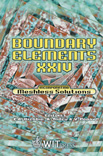An Improved DRM Representation Of Partial Derivatives
Price
Free (open access)
Transaction
Volume
32
Pages
13
Published
2002
Size
513 kb
Paper DOI
10.2495/BE020361
Copyright
WIT Press
Author(s)
B Natalini & V Popov
Abstract
The dual reciprocity method (DRM) is one of the most efficient boundary element (BEM) procedures to take the domain integrals to the boundary. The DRM when applied to advection-diffusion problems requires an algorithm to represent the partial derivatives introduced by the convective term. The classical procedure expresses them as a function of the potentials employing an approximation function. The Dual Reciprocity Method Multy-Domain (DRM-MD) is a technique which combines DRM and domain decomposition for a case when the domain is subdivided in a very large number of subregions and the resulting internal mesh pattern looks like a finite element grid. In the DRM-MD the partial derivatives can be represented either in the classical way or as functions of the normal derivatives. In this paper a set of examples of advection-diffusion problems which have been solved using DRM-MD codes with both formulations in first partial derivatives are presented. It is shown that the classical formulation produces large numerical errors when the approximation function is 1 + r, which can be removed with the new approach, and that the classical formulation provides suitable results when the approximation function is the augmented thin plate spline.
Keywords





